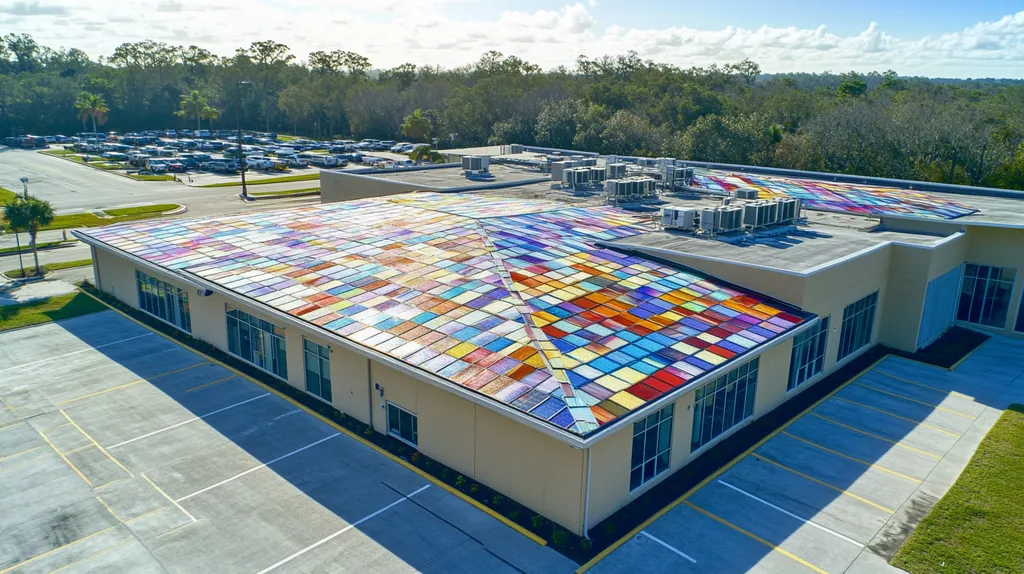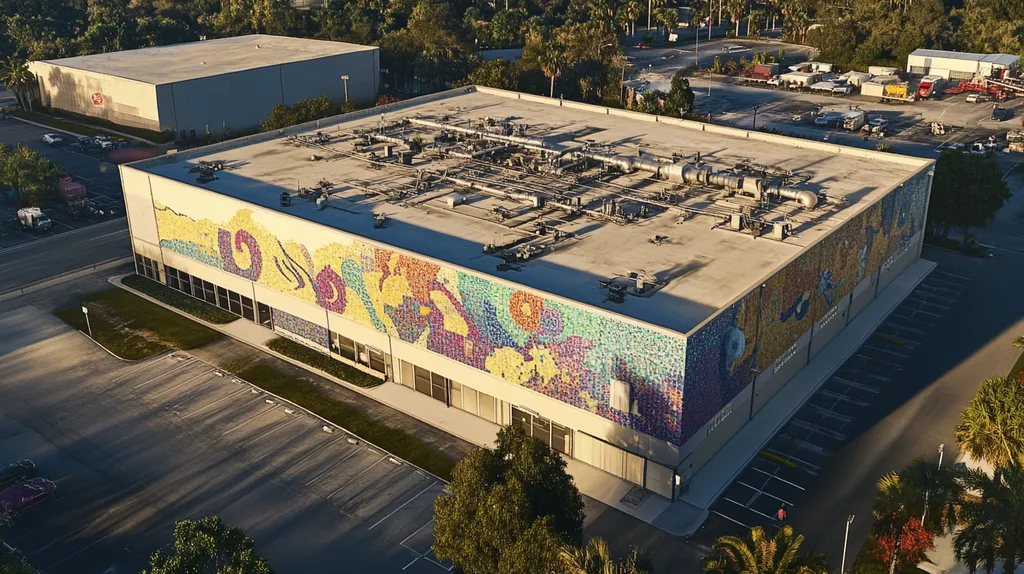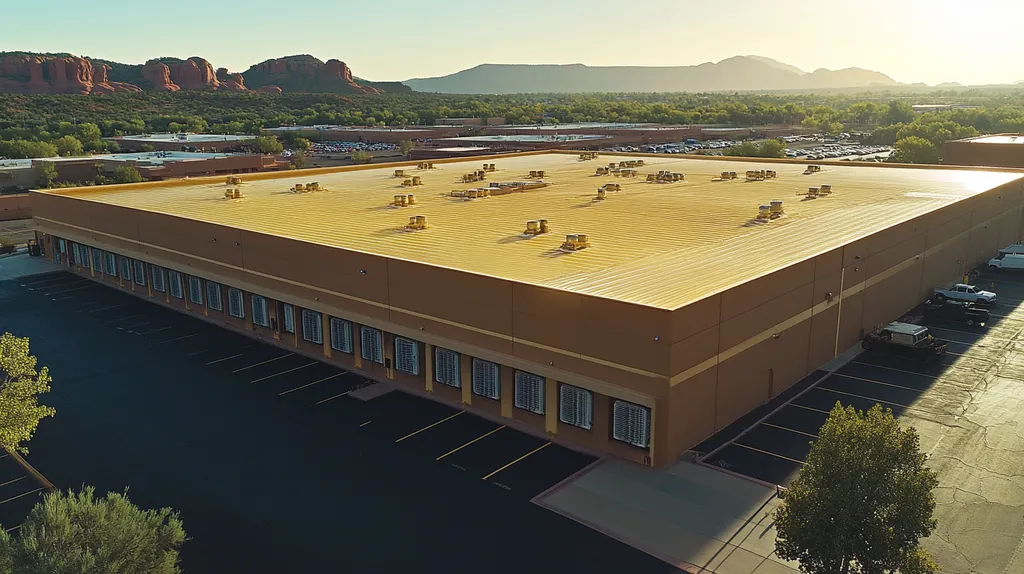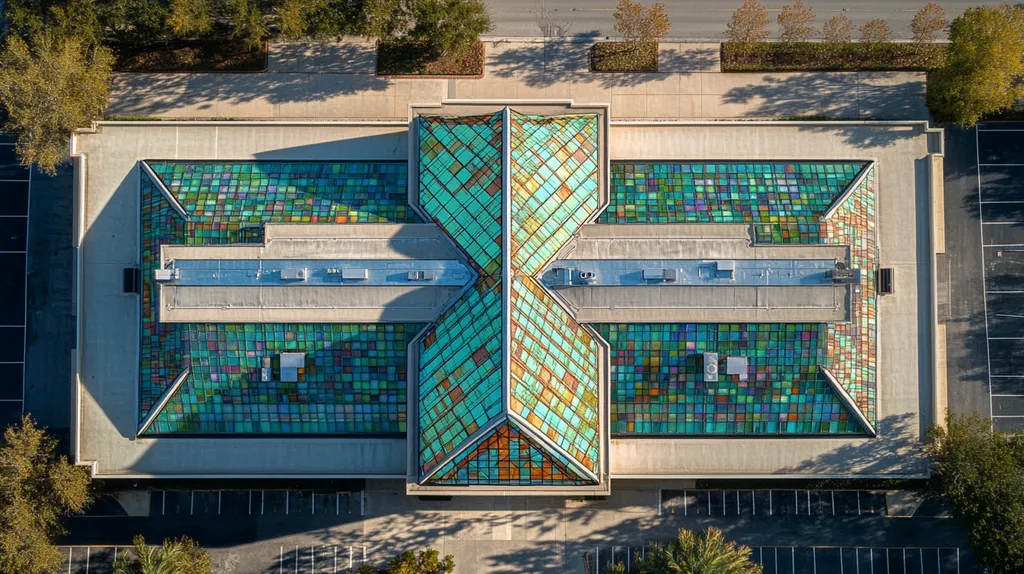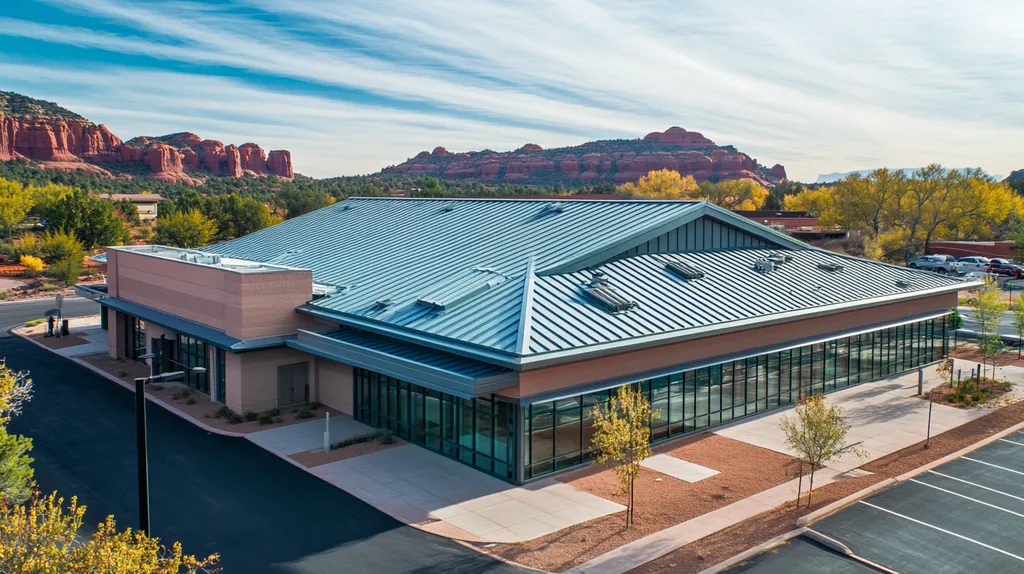In the past decade, weather-related commercial roof failures have increased by 175%, with repair costs now averaging $450,000 per incident. This surge in extreme weather events has transformed how the industry approaches roof installation and maintenance.
The traditional methods that served well through the 20th century now prove inadequate against unprecedented temperature swings, wind forces, and precipitation levels.
This comprehensive guide examines how severe weather impacts every aspect of commercial roofing, from material selection through long-term performance monitoring, providing facility managers with essential strategies for protecting their investments.
SECTION 1: FUNDAMENTAL CONCEPTS
The escalating intensity of extreme weather events has transformed commercial roofing from a routine maintenance concern into a critical risk management challenge. Recent data shows that weather-related roof damage claims have surged by 30% in the past decade, with repair costs averaging $250,000 per incident. Understanding the fundamental relationship between weather phenomena, roofing materials, and design principles has become essential for protecting commercial investments.
Weather Phenomena Impacting Commercial Roofs
Today’s weather patterns present unprecedented challenges to commercial roofs. Heat waves reach higher temperatures, storms pack stronger winds, and precipitation events dump more water than systems designed just two decades ago were built to handle.
The cycling between extreme conditions compounds these challenges. A roof that expands under intense summer heat must also withstand rapid contraction during sudden cold fronts, creating stress patterns that accelerate wear.
Climate zone boundaries are shifting, forcing many facilities to contend with weather patterns their roofs weren’t originally engineered to handle. What worked in the 1990s may now be insufficient for current conditions.
Even seemingly minor weather events can cascade into major issues. Morning dew followed by intense afternoon heat creates daily stress cycles that can prematurely age roofing materials.
Mechanics of Roof Material Weather Resistance
Prolonged sun exposure triggers a cascade of material degradation in commercial roofs. UV rays break down molecular bonds, causing cracking and blistering while reducing material elasticity and thickness. (source: Castagra)
Different roofing materials exhibit unique responses to weather stress. Single-ply membranes like TPO excel at reflecting heat but may become brittle in extreme cold, while built-up roofing provides excellent water resistance but can suffer under thermal cycling.
The interface between different roofing components often becomes the weak point during weather events. Flashing, seams, and penetrations require special attention as they’re typically the first to show signs of weather-related deterioration.
Modern roofing systems incorporate multiple layers of weather resistance. The success of these systems depends on each layer maintaining its integrity while working in concert with adjacent materials.
Interaction Between Roof Design and Climate Stressors
Roof design must evolve beyond simple shelter to become an active defense system against weather extremes. Strategic placement of drainage paths, expansion joints, and insulation layers can dramatically improve a roof’s resilience.
The pitch and orientation of roof surfaces significantly influence their weather resistance. Even subtle adjustments to these factors can enhance drainage, reduce wind uplift potential, and optimize solar reflection.
Modern designs incorporate redundant protection layers. When one component faces stress, others can compensate, creating a more robust system that maintains integrity even under severe conditions.
Smart design anticipates future climate trends. Forward-thinking facilities now specify systems rated for conditions projected decades ahead, rather than relying solely on historical weather data.
SECTION 2: SYSTEM COMPONENTS
Modern commercial roofs face unprecedented challenges from extreme weather events. In the past five years alone, weather-related roof failures have resulted in over $2 billion in commercial property damage. Understanding how each roofing component responds to severe conditions has become crucial for protecting these substantial investments.
Roofing Membranes and Their Weather Performance
Prolonged sun exposure triggers a cascade of material degradation in commercial roofs. UV rays break down molecular bonds, causing cracking and blistering while reducing material elasticity and thickness. (source: Castagra)
Each membrane type offers distinct weather resistance characteristics. TPO excels in reflecting solar radiation but can become brittle in extreme cold, while EPDM provides superior flexibility but may require additional UV protection.
Material thickness plays a crucial role in weather resistance. While 45-mil membranes meet minimum standards, 60-mil or thicker materials offer substantially better protection against hail and puncture damage.
The membrane’s surface texture affects both water shedding and heat absorption. Smooth surfaces generally drain better but may accumulate more heat, while textured finishes offer better traction but can trap debris.
Structural Elements and Fastening Systems
Today’s structural support systems must accommodate increasing load requirements. Steel decking thickness and profile depth directly impact a roof’s ability to handle snow loads and equipment weight.
Mechanical fastening patterns have evolved beyond traditional grid layouts. Enhanced corner and perimeter fastening density now accounts for variable wind uplift forces across the roof surface.
Thermal bridging through fasteners can compromise energy efficiency. New composite fastener designs and installation techniques help maintain the thermal barrier while ensuring secure attachment.
Support spacing and reinforcement zones require careful calculation. What worked for weather patterns a decade ago may prove insufficient for today’s more intense storms.
Roof Edge, Flashings, and Penetrations Vulnerabilities
Edge metal systems serve as the first line of defense against wind uplift. Modern profiles incorporate multiple defense layers, including water dams, drip edges, and enhanced attachment methods.
Flashing details at transitions and penetrations demand particular attention. These critical junctions must maintain watertight integrity while accommodating building movement and thermal expansion.
New penetration sealing technologies combine flexibility with durability. Pre-manufactured boots and liquid-applied sealants provide superior protection compared to traditional field-fabricated solutions.
Regular inspection of these vulnerable areas prevents catastrophic failures. Small breaches in flashings or edge metal can quickly escalate into major structural damage during extreme weather events.
SECTION 3: IMPLEMENTATION METHODS
The surge in extreme weather events demands a fundamental shift in commercial roofing implementation. Recent data shows weather-related roof failures costing businesses an average of $3.4 million per incident when accounting for repairs, inventory damage, and operational disruptions. This section explores the critical methodologies that determine a roof’s resilience, from initial site assessment through material selection and installation techniques.
Site-Specific Weather Risk Assessment Techniques
Monsoons and severe weather events pose unique challenges for commercial roofs across different regions, making thorough site-specific assessments essential for long-term roof performance. Properties in storm-prone areas require enhanced drainage systems and specialized waterproofing solutions to prevent catastrophic failures. (source: CentiMark)
Modern risk assessments incorporate historical weather data, local topography, and building-specific factors. These evaluations must account for wind patterns, precipitation levels, and temperature fluctuations that could compromise roof integrity.
Digital mapping and climate modeling tools now enable precise prediction of weather-related stress points. This technology helps identify vulnerable areas before they develop into costly problems.
Regular reassessment schedules ensure that protective measures evolve with changing weather patterns. What worked five years ago may no longer provide adequate protection against today’s more intense weather events.
Installation Best Practices for Extreme Weather Resilience
Proper installation techniques directly impact a roof’s ability to withstand severe weather conditions. Enhanced fastening patterns, reinforced perimeter attachments, and proper drainage slopes form the foundation of weather-resistant installations.
Strategic placement of expansion joints and additional support structures helps roofs accommodate thermal movement. These features prevent stress-related damage during extreme temperature swings.
Modern installation methods emphasize redundant water barriers at critical points. Multiple layers of protection at seams, penetrations, and transitions provide backup systems when primary barriers face extreme stress.
Quality control protocols during installation must verify proper material handling and application temperatures. Even minor deviations from manufacturer specifications can compromise a roof’s weather resistance.
Use of Certified Materials and Manufacturer Guidelines
Material selection must prioritize products tested and rated for regional weather extremes. High-performance membranes, advanced adhesives, and impact-resistant components provide superior protection against severe conditions.
Manufacturer certifications validate material performance claims through standardized testing. These certifications help facility managers compare products objectively and select appropriate solutions.
Following manufacturer guidelines ensures compatibility between system components. Modern roofing assemblies function as integrated systems, requiring precise attention to material interactions.
Documentation of material specifications and installation procedures creates accountability throughout the project. This record-keeping proves invaluable for warranty claims and future maintenance planning.
SECTION 4: MAINTENANCE REQUIREMENTS
The landscape of commercial roof maintenance has transformed dramatically as weather patterns grow more extreme. Recent industry data reveals that proactive maintenance programs reduce unexpected roof failures by 70% and extend system lifespan by up to 8 years. Yet many facilities still rely on reactive approaches, leading to premature roof replacement and preventable damage. This section examines how structured maintenance protocols, strategic repairs, and systematic documentation create resilient roofing systems capable of withstanding today’s weather challenges.
Regular Inspection Protocols for Weather Damage
Extreme weather events like heavy rain, high winds, hail, snow, and ice can take a serious toll on even durable commercial roofs. Regular inspections performed by qualified professionals have become essential for identifying potential vulnerabilities before they lead to system failure. (source: Castagra)
Modern inspection protocols utilize advanced diagnostic tools including infrared scanning, moisture mapping, and drone photography. These technologies detect hidden issues that visual inspections might miss, particularly after severe weather events.
Seasonal inspection timing should align with regional weather patterns. Spring assessments identify winter damage, while fall inspections ensure readiness for upcoming cold weather challenges.
Core inspection points include membrane seams, flashings, drainage systems, and mechanical attachments. Special attention focuses on areas where different materials meet, as these interfaces often show the first signs of weather stress.
Preventative Repairs and Reinforcement Strategies
Today’s approach to preventative maintenance emphasizes strategic reinforcement of vulnerable areas before damage occurs. This includes applying additional membrane protection at high-traffic zones and strengthening edge details where wind forces concentrate.
Modern repair materials offer superior weather resistance compared to traditional patches. Advanced sealants and reinforced membranes provide longer-lasting protection while maintaining system integrity.
Drainage enhancement remains crucial for preventing water accumulation. Installing additional drains, maintaining clear flow paths, and ensuring proper slope helps roofs shed water efficiently during intense storms.
Regular maintenance of mechanical equipment supports and penetration seals prevents weather-related stress points. These often-overlooked components play vital roles in overall system performance.
Documentation and Contractor Coordination Processes
Digital documentation platforms have revolutionized maintenance tracking, enabling detailed historical records of inspections, repairs, and weather events. These systems help identify patterns and predict potential failure points.
Contractor coordination now requires clear communication protocols and defined response times. Emergency response plans should outline specific procedures for different weather scenarios.
Maintenance schedules must adapt to changing weather patterns. What worked a decade ago may prove insufficient against today’s more frequent and intense storms.
Quality assurance programs verify that all maintenance work meets current standards. Regular audits ensure contractors follow prescribed procedures and use approved materials.
SECTION 5: PERFORMANCE METRICS
The intensifying frequency and severity of extreme weather events has transformed performance metrics from simple maintenance guidelines into critical risk management tools. Recent industry data shows that roofs failing to meet current performance standards face a 300% higher risk of catastrophic failure during severe weather. Understanding and tracking these metrics has become essential for protecting multi-million dollar commercial properties and the operations they house.
Indicators of Roof Integrity Under Weather Stress
Modern integrity indicators extend far beyond visual inspections. Advanced monitoring systems now track membrane elongation, seam strength, and thermal movement in real-time.
Drainage performance metrics have evolved to account for unprecedented rainfall intensities. Systems must now demonstrate capacity for handling 500-year storm events rather than traditional 100-year benchmarks.
Wind resistance indicators now incorporate both static and dynamic pressure measurements. These metrics help identify vulnerable areas before they experience actual wind damage.
Surface degradation measurements track changes in material properties over time. Regular assessment of reflectivity, thickness, and flexibility helps predict remaining service life under extreme conditions.
Load and Pressure Testing Standards
Prolonged exposure to extreme conditions can trigger cascading material failures in commercial roofs. UV radiation degrades molecular bonds, while thermal cycling stresses seams and attachments, making regular load testing essential for predicting performance under stress. (source: Castagra)
Modern load testing protocols simulate multiple stress factors simultaneously. This approach better reflects real-world conditions where high winds combine with heavy rain or extreme temperatures.
Pressure differential measurements across the roof assembly have become increasingly important. These tests identify weak points in the air barrier system that could lead to devastating uplift failures.
Impact resistance testing now incorporates larger hail sizes and higher impact velocities. These enhanced standards reflect the increasing intensity of severe weather events.
Monitoring Long-Term Material Degradation
Systematic tracking of material degradation provides crucial early warning of potential failures. Monthly measurements of membrane thickness, seam strength, and surface condition create trending data that reveals deterioration patterns.
Chemical analysis of roof samples helps identify environmental stressors affecting material performance. This data guides the selection of protective treatments and timing of preventive repairs.
Thermal imaging and moisture detection systems provide non-destructive evaluation of insulation performance. Regular scanning helps track degradation patterns that could compromise the roof’s thermal efficiency.
Documentation of weathering effects creates valuable performance history. This data helps predict future degradation rates and optimize maintenance scheduling for maximum roof longevity.
SECTION 6: OPTIMIZATION STRATEGIES
Just as the horse-and-buggy gave way to automobiles, traditional commercial roofing approaches are proving inadequate against today’s weather extremes. The past decade has seen a 400% increase in severe weather events causing catastrophic roof failures, with average repair costs exceeding $500,000 per incident. This dramatic shift demands a wholesale reimagining of how we optimize commercial roofs, moving beyond simple maintenance to implementing comprehensive weather resilience strategies.
Retrofitting Existing Roofs for Severe Weather
The evolution of commercial roofing has entered a critical phase where existing structures must adapt or fail. Strategic retrofitting can transform vulnerable roofs into weather-resistant shields, but the process requires careful assessment and systematic upgrades.
Modern retrofitting begins at the deck level, reinforcing structural components to handle increased stress loads. Additional fasteners, enhanced perimeter attachments, and supplemental bracing create a more robust foundation for severe weather resistance.
Vapor barriers and insulation layers must be upgraded to combat more extreme temperature swings. These modifications not only protect against condensation but also reduce thermal stress on the roofing membrane.
The integration of monitoring systems during retrofitting provides early warning of potential failures. Sensors tracking membrane movement, moisture levels, and structural loads help facility managers anticipate and prevent weather-related damage.
Enhancing Drainage and Moisture Management
Where traditional drainage systems were designed for steady rainfall, modern solutions must handle sudden deluges. Enhanced scupper sizing, auxiliary drainage paths, and intelligent slope design work together to prevent catastrophic ponding.
Internal drainage networks now incorporate redundant pathways and overflow protection. This layered approach ensures water evacuation continues even if primary drains become overwhelmed during extreme events.
Advanced moisture detection systems enable precise tracking of water movement through the roof assembly. This technology helps identify potential failure points before they develop into costly leaks.
The integration of smart drainage controls allows systems to adapt to changing weather conditions. Automated mechanisms can adjust flow rates and redirect water based on real-time precipitation data.
Integration of Weather-Resistant Technologies and Coatings
Prolonged exposure to extreme conditions can trigger cascading material failures in commercial roofs. UV radiation degrades molecular bonds, while thermal cycling stresses seams and attachments, making protective coatings essential for maintaining structural integrity. (source: Castagra)
Smart membrane systems incorporate self-healing capabilities and enhanced UV resistance. These materials actively respond to damage, sealing minor breaches before they can develop into significant problems.
Nanotechnology-enhanced coatings provide superior protection against moisture infiltration and chemical exposure. These advanced formulations maintain their protective properties longer than traditional materials.
The latest coating systems offer multi-layer protection while maintaining flexibility. This combination ensures continued performance even as buildings shift and settle over time.
Looking Ahead
The commercial roofing industry stands at a critical inflection point, with weather-related failures increasing 175% in just five years and average repair costs now exceeding $450,000 per incident.
Traditional roofing approaches developed for 20th-century weather patterns can no longer adequately protect modern facilities against today’s extreme conditions.
The integration of advanced materials, smart monitoring systems, and enhanced installation protocols has become essential rather than optional.
As weather patterns continue to intensify, the difference between a resilient roof and a catastrophic failure increasingly depends on systematic implementation of the comprehensive strategies outlined in this guide.
The future of commercial roofing belongs to those who embrace these evolutionary changes, protecting their facilities through proactive adaptation rather than reactive repairs.
FREQUENTLY ASKED QUESTIONS
Q. How do extreme weather events impact commercial roofs?
A. Extreme weather makes roofs face increased risks and potential damages. Factors like intense heat, strong winds, and heavy rain can speed up material wear and compromise roof integrity. Understanding these dangers is crucial for effective protection and risk management.
Q. What roof components are affected by severe weather on industrial roofs?
A. Key components like roofing membranes, flashings, and structural elements are greatly affected. Each material’s response varies, and modern systems rely on an integrated approach for ensuring complete weather resilience. Neglecting these factors can lead to unforeseen failures.
Q. How can I assess the weather risks to my commercial roof?
A. Conducting a site-specific weather risk assessment is vital for long-lasting protection. Factors to analyze include historical weather data, local topography, and any unique vulnerabilities your building may have. This proactive step can identify risks before they turn into costly issues.
Q. What key maintenance practices ensure resilience for commercial roofs?
A. Regular inspections and preventative repairs form the backbone of effective maintenance. Implementing a proactive maintenance approach significantly minimizes unexpected failures and extends overall system lifespan. Identifying vulnerabilities during inspections allows for timely interventions to maintain roof integrity.
Q. What performance metrics should I monitor for my commercial roof?
A. Critical indicators include membrane elongation, seam strength, and drainage capacity. Monitoring these metrics facilitates early detection of potential issues and ensures your roof meets current performance standards. Keeping track of these elements enables effective risk management for commercial properties.
Q. How can retrofitting enhance commercial roof performance in severe weather?
A. Retrofitting can significantly improve structural integrity by upgrading components to handle increased loads. Adding fasteners and reinforcing insulation helps bolster resistance against extreme conditions. Implementing these changes prepares existing roofs for modern weather challenges.
Q. What innovative technologies can improve commercial roof durability?
A. Technologies like smart membranes and advanced coatings enhance weather resistance and durability. These might include self-healing capabilities or nano-coatings, which actively protect roofing surfaces from environmental stressors. Incorporating these innovations optimizes roof longevity in the face of extreme weather.

